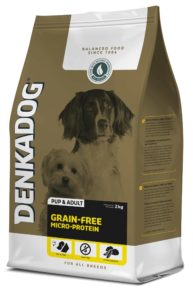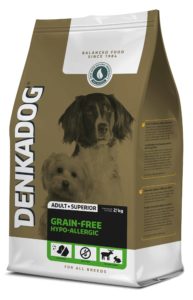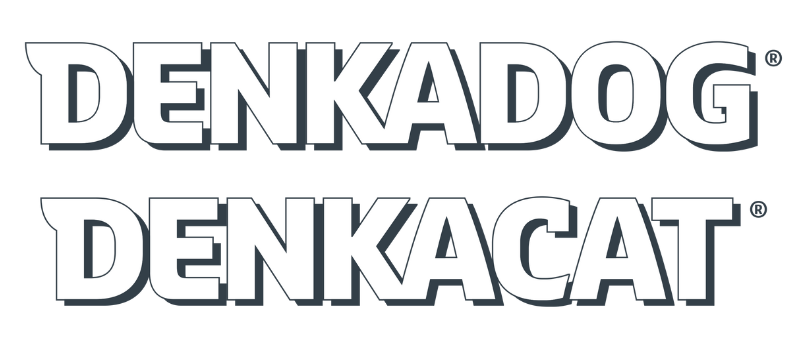Grains in dog food, what do you need to know?
- Grains in dog food are easily digestible;
- Good source of energy;
- Grain free dog food is different from gluten free dog food;
- Gluten are proteins with a specific property;
- Animal protein allergy is more common than gluten allergy.
Why grains in dog food?
Grains are needed to create a balanced diet and to guarantee the binding and structure of the grain. In addition, grains promote optimal intestinal function. The fibers stimulate intestinal movements. The digestibility of grains is much higher than the digestibility of, for example, meat (protein, fat). The digestibility of all grains is very close to each other. Grains provide fuel for the body as a source of carbohydrates and are used for energy. Although dogs can do without carbohydrates, they are a very good source of energy. Corn and rice are desirable ingredients in dog food, also because of their consistent quality. In addition, corn and rice are free of gluten. This makes corn and rice suitable for dogs with a gluten sensitivity. Usually, the rice in dog food is not the quality of rice used for human consumption. The quality of corn used in Denkadog food is comparable to human food.
Grains in dog food: useful or not for my dog?
Opinions on the most suitable food for dogs vary widely. Grain-free food is becoming increasingly popular.
Grain-free dog food
Grain-free means that no ingredients are processed that belong to the group of grains. Wheat, rice, corn, barley, oats and rye are commonly used grains. Grain-free dog food is often composed of potatoes, broad beans, lentils, sweet potato and or peas. These ingredients contain carbohydrates (starch) just like grains and are good energy suppliers for the body. A number of non-grain products have disadvantages for digestion in dogs. Potatoes have the disadvantage that if too many (low quality) potatoes are used, there is an increased risk of diarrhea. Peas and beans are less easy to digest. Just think if you eat pea soup for 3 days. Sweet potato does not have these properties, but comes from the other side of the world and you can ask yourself whether you want that in terms of CO2 foodprint if there are also very good carbohydrate sources (grains) available from our own country.
We have 2 grain-free products:
1. Grain-Free Micro-Protein is for puppies and adult dogs with food allergies and help to diagnose them.

2. Grain-Free Hypo-Allergic is for adult dogs with food allergies.

What is grain or gluten allergy?
Grain allergy and gluten allergy are terms that are sometimes used interchangeably. This confusion arises because many grains contain gluten (wheat, rye and barley). Grain-free dog food is always gluten-free. Gluten-free dog food is not automatically grain-free, because gluten-free dog food can contain rice and corn. Gluten are proteins that occur in rye, wheat and barley. In humans, we know of a condition in which these people have problems with gluten. In dogs, this is very rare. Hypersensitivity to proteins in meat is more common in dogs. Grain-free dog food is always gluten-free.
Gluten-free dog food reduces the risk of allergic reactions
Gluten-free dog food is very suitable for dogs that are allergic to wheat, rye and/or barley. This food is usually specially developed for food-sensitive and food-allergic dogs.
Gluten-free food from Denkadog
* Hypo Sensitive (without animal ingredients / vegetarian food)
* Hypo Allergic (lamb)
* Micro Protein (hydrolyzed proteins)
* Joints Care (for flexible joints)
* Dental Care (against tartar)
* Grain-Free Hypo-Allergic (prevents allergic reaction)
* Grain-Free Micro-Protein (prevents allergic reaction)
Can dogs digest grains?
Dogs can digest grains perfectly well if the grains are heated (unlocked). This is proven in practice, but research also shows this. Dogs are perfectly capable of digesting large amounts of starch (grain and potato). The condition is that the starch from the ingredients is fully unlocked (unlocked starch is almost 98% digestible for dogs, but also for humans). The baker also bakes his bread by heating and this also unlocks the starch. Unlocking peas or beans is much more difficult than from grain or potato.
Mention on the packaging
Despite strict legislation from Europe, there are still uncertainties about what is in the bag regarding the information on the packaging. A mention of grains on the packaging does not yet indicate which grains (wheat, barley, oats, rice, sorghum, spelt, amaranth, etc.) have been processed and of what quality they are.
Example: when mentioning rice, it does not indicate whether we are dealing with rice, rice flour, rice gluten or rice bran. The digestibility of rice flour is 90% and the digestibility of rice bran is 46%. The latter is half as digestible, so the price of rice bran is also half that of rice. Corn provides better digestibility than rice bran. Wheat provides better digestibility than oats or barley. Corn and wheat are therefore the most fully digestible grains used in dog food.
Grain-free foods that are now trendy as “grain-free” often contain potatoes (starch), sweet potatoes, peas, beans or even lentils instead of grains. These ingredients also provide starch as fuel for the body. They differ from grains in that the digestibility is often less, as with peas (think of pea soup, for example).
Still can't see the forest for the trees? With our knowledge and experience, we are happy to help you find the most suitable food for your dog? Send an email to info@denkadog.nl or call 073 - 7600475.
Follow us on Social Media







